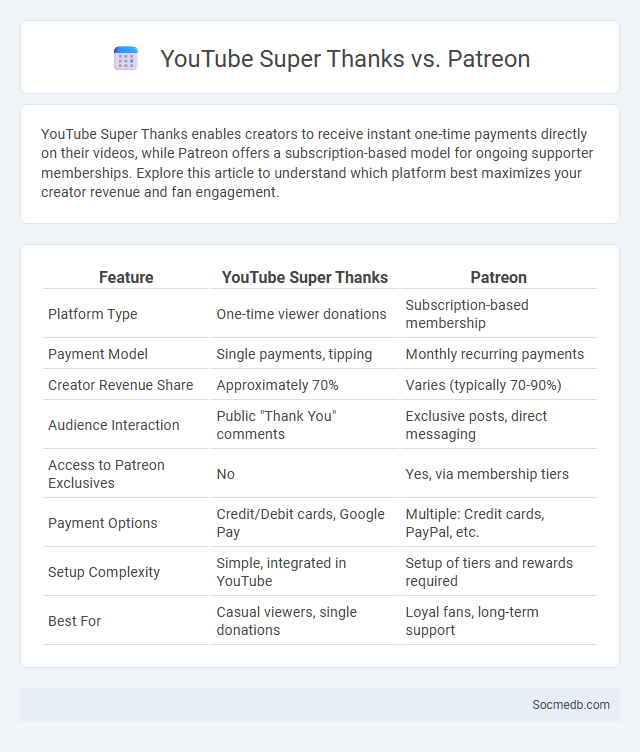
Photo illustration: YouTube Super Thanks vs Patreon
YouTube Super Thanks enables creators to receive instant one-time payments directly on their videos, while Patreon offers a subscription-based model for ongoing supporter memberships. Explore this article to understand which platform best maximizes your creator revenue and fan engagement.
Table of Comparison
| Feature | YouTube Super Thanks | Patreon |
|---|---|---|
| Platform Type | One-time viewer donations | Subscription-based membership |
| Payment Model | Single payments, tipping | Monthly recurring payments |
| Creator Revenue Share | Approximately 70% | Varies (typically 70-90%) |
| Audience Interaction | Public "Thank You" comments | Exclusive posts, direct messaging |
| Access to Patreon Exclusives | No | Yes, via membership tiers |
| Payment Options | Credit/Debit cards, Google Pay | Multiple: Credit cards, PayPal, etc. |
| Setup Complexity | Simple, integrated in YouTube | Setup of tiers and rewards required |
| Best For | Casual viewers, single donations | Loyal fans, long-term support |
Introduction to Fan Funding Platforms
Fan funding platforms revolutionize content creation by enabling direct monetary support from audiences to creators. Platforms like Patreon, Ko-fi, and Buy Me a Coffee provide sustainable revenue streams, fostering closer fan-creator relationships. These tools leverage social media integration, allowing seamless promotion and engagement to boost financial contributions.
What is YouTube Super Thanks?
YouTube Super Thanks is a feature that allows viewers to support their favorite creators by purchasing a highlighted comment on a video. This interaction helps creators earn revenue directly from their audience, boosting engagement and encouraging content quality. By using Super Thanks, you make your appreciation visible while contributing to the growth of channels you enjoy.
Overview of Patreon for Creators
Patreon provides creators with a platform to monetize their content through direct support from fans, offering subscription-based membership tiers that foster ongoing revenue streams. By enabling You to build a community around exclusive content and rewards, Patreon enhances creator independence beyond traditional ad revenue models. The platform's tools for analytics, communication, and payment processing streamline your ability to engage and grow a dedicated audience.
Alternative Fan Funding Methods
Alternative fan funding methods on social media platforms include crowdfunding, subscription services, and direct donations via digital wallets or payment links. Platforms such as Patreon, Ko-fi, and Buy Me a Coffee enable creators to receive consistent financial support from their audience without relying on traditional advertising revenue. These methods foster a closer connection between creators and fans while providing a sustainable income stream in a rapidly evolving digital landscape.
Key Features Comparison
Social media platforms vary significantly in features, with Facebook offering extensive community-building tools like groups and events, while Instagram emphasizes visual content through Stories, Reels, and IGTV. Twitter prioritizes real-time updates and concise communication with a 280-character limit, using hashtags and trending topics for engagement. LinkedIn stands out for professional networking, featuring robust job search capabilities, endorsements, and detailed user profiles optimized for career advancement.
Revenue Share and Fees
Social media platforms generate significant revenue through advertising, subscription services, and in-app purchases, often implementing revenue share models where creators receive a percentage of the earnings. Your income from these platforms is impacted by fees and commission rates, which can vary widely between services, sometimes ranging from 10% to 30% of the total revenue. Understanding the specific revenue share agreements and fee structures is essential to maximizing your profitability on social media channels.
Monetization Flexibility
Social media platforms offer diverse monetization flexibility through features such as ad revenue sharing, sponsored content, and direct fan support via subscriptions or tipping. Creators can tailor their income streams by leveraging tools like affiliate marketing, branded partnerships, and e-commerce integrations directly within their profiles. This adaptability enables users to optimize earnings based on audience engagement and content type, driving sustainable digital entrepreneurship.
Audience Engagement Tools
Audience engagement tools on social media include features like polls, live videos, stories, and interactive posts that boost user interaction and foster a sense of community. Leveraging analytics tools helps you track engagement metrics such as likes, shares, comments, and click-through rates, enabling precise targeting and content optimization. Your strategic use of these tools enhances brand loyalty, increases reach, and drives meaningful conversations with followers.
Pros and Cons of Each Platform
Facebook offers robust community-building tools and targeted advertising options but can face issues with privacy concerns and algorithm-driven content bubbles. Instagram excels in visual storytelling and influencer marketing but may contribute to unrealistic lifestyle expectations and time-consuming scrolling habits. Twitter provides real-time news updates and open conversations, though it often struggles with misinformation and toxic interactions, impacting Your social media experience.
Choosing the Right Fan Funding Solution
Choosing the right fan funding solution on social media impacts creator revenue and audience engagement significantly. Platforms like Patreon, Ko-fi, and Buy Me a Coffee offer tailored features such as subscription models, one-time donations, and tiered membership options that align with different creator needs. Evaluating transaction fees, integration capabilities, and audience preferences ensures optimal monetization and sustainable fan support.
 socmedb.com
socmedb.com